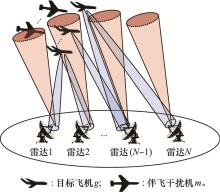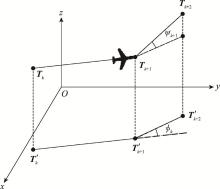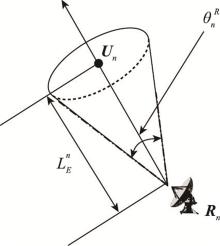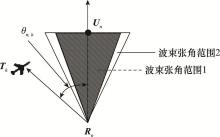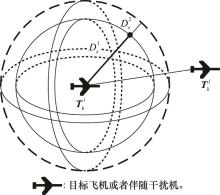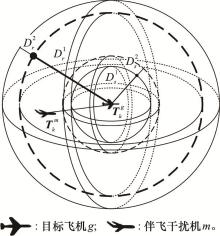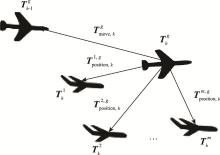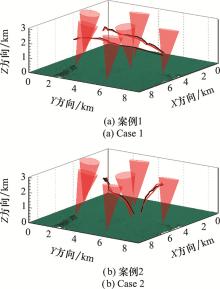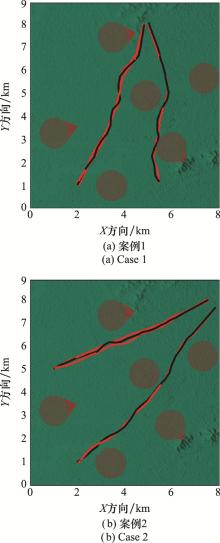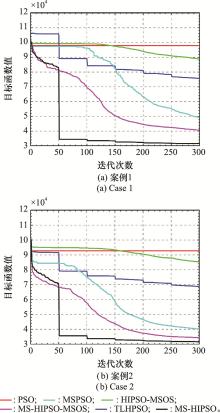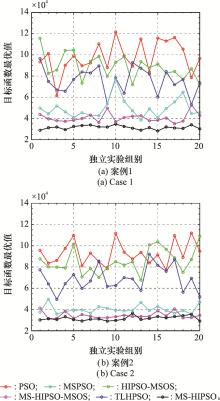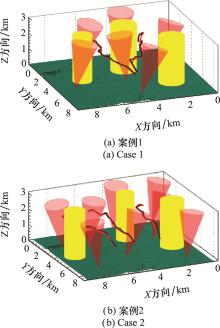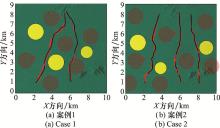Systems Engineering and Electronics ›› 2024, Vol. 46 ›› Issue (8): 2807-2819.doi: 10.12305/j.issn.1001-506X.2024.08.28
• Guidance, Navigation and Control • Previous Articles
Multi-syndrome jammers formation trajectory preplanning method for netted radar jamming task
Weiqi ZOU, Chaoyang NIU, Wei LIU, Yanyun WANG, Jiaqi ZHAN
- School of Data and Target Engineering, PLA Strategic Support Force InformationEngineering University, Zhengzhou 450001, China
-
Received:2022-10-18Online:2024-07-25Published:2024-08-07 -
Contact:Chaoyang NIU
CLC Number:
Cite this article
Weiqi ZOU, Chaoyang NIU, Wei LIU, Yanyun WANG, Jiaqi ZHAN. Multi-syndrome jammers formation trajectory preplanning method for netted radar jamming task[J]. Systems Engineering and Electronics, 2024, 46(8): 2807-2819.
share this article
Table 3
Starting and end point of the multi-syndrome jammers formation m"
| 案例 | 威胁类型 | 起点坐标 | 终点坐标 |
| 案例1 | 目标飞机1 | (2 000, 1 000, 1 500) | (4 850, 7 900, 1 600) |
| 伴飞干扰机1 | (2 040, 970, 1 460) | (4 890, 7 870, 1 560) | |
| 伴飞干扰机2 | (1 960, 1 040, 1 450) | (4 820, 7 930, 1 560) | |
| 目标飞机2 | (5 500, 1 100, 1 700) | (5 000, 8 000, 1 500) | |
| 伴飞干扰机3 | (5 460, 1 070, 1 650) | (4 970, 7 970, 1 460) | |
| 案例2 | 目标飞机1 | (1 000, 5 000, 1 500) | (7 700, 8 000, 1 600) |
| 伴飞干扰机1 | (1 030, 4 970, 1 460) | (7 730, 7 970, 1 560) | |
| 伴飞干扰机2 | (960, 5 030, 1 460) | (7 670, 8 030, 1 560) | |
| 目标飞机2 | (2 000, 1 000, 1 600) | (8 000, 7 700, 1 500) | |
| 伴飞干扰机3 | (1 970, 970, 1 560) | (7 970, 7 670, 1 460) |
Table 4
Indicators of the optimal solution (case 1)"
| 算法 | 最佳值 | 最差值 | 平均值 | 标准值 |
| PSO | 61 408.48 | 121 548.60 | 97 988.52 | 14 890.010 |
| HIPSO-MSOS | 71 944.86 | 115 643.50 | 88 804.44 | 11 697.120 |
| TLHPSO | 53 232.81 | 96 403.49 | 75 743.96 | 12 239.290 |
| MSPSO | 38 532.29 | 77 287.50 | 49 390.56 | 9 067.083 |
| MS-HIPSO-MSOS | 34 992.36 | 52 625.60 | 40 684.50 | 4 381.268 |
| MS-TLHPSO | 28 267.81 | 34 743.45 | 31 519.64 | 1 770.986 |
Table 5
Indicators of the optimal solution (case 2)"
| 算法 | 最佳值 | 最差值 | 平均值 | 标准值 |
| PSO | 77 337.96 | 111 948.1 | 92 770.48 | 10 825.57 |
| HIPSO-MSOS | 67 573.74 | 108 921.2 | 85 384.60 | 11 694.55 |
| TLHPSO | 49 503.04 | 92 075.05 | 68 768.80 | 11 709.960 |
| MSPSO | 35 662.75 | 49 534.39 | 40 123.17 | 3 826.639 |
| MS-HIPSO-MSOS | 31 403.77 | 41 296.28 | 34 359.15 | 2 988.954 |
| MS-TLHPSO | 29 013.56 | 36 412.56 | 31 575.41 | 2 098.378 |
Table 6
Average value of the optimal solution of each algorithm in different initial scenarios"
| 初始场景设置 | 算法 | |||||||||
| 目标飞机数量 | 伴飞干扰机数量 | 障碍威胁数量 | 雷达威胁数量 | PSO | HIPSO-MSOS | TLHPSO | MSPSO | MS-HIPSO-MSOS | MS-TLHPSO | |
| 2 | 5 | 2 | 5 | 112 021.8 | 102 047.3 | 88 304.52 | 58 416.52 | 45 616.73 | 36 981.38 | |
| 2 | 5 | 3 | 5 | 124 920.8 | 112 531.7 | 98 072.05 | 62 730.71 | 43 647.15 | 39 319.46 | |
| 2 | 5 | 2 | 6 | 134 623.2 | 122 112.4 | 105 192.8 | 65 916.11 | 54 213.27 | 40 541.88 | |
| 2 | 5 | 3 | 6 | 139 458.3 | 126 480.2 | 106 159.8 | 70 790.07 | 54 569.38 | 42 264.37 | |
| 3 | 8 | 2 | 7 | 143 154.3 | 129 523.3 | 108 216.8 | 70 764.17 | 55 080.31 | 43 629.74 | |
| 3 | 8 | 3 | 7 | 161 610.2 | 144 658.9 | 114 317.2 | 77 080.74 | 55 089.16 | 44 525.14 | |
| 3 | 8 | 2 | 8 | 176 181.7 | 159 536.2 | 125 512.2 | 93 452.32 | 65 466.46 | 55 514.68 | |
| 3 | 8 | 3 | 8 | 189 767.2 | 171 007.3 | 138 266.4 | 93 887.86 | 67 802.71 | 57 264.87 | |
| 3 | LEE K S, OVINIS M, NAGARAJAN T, et al. Autonomous patrol and surveillance system using unmanned aerial vehicles[C]//Proc. of the IEEE 15th International Conference on Environment and Electrical Engineering, 2015: 1291-1297. |
| 4 | SONG B D , PARK K , KIM J .Persistent UAV delivery logistics: MILP formulation and efficient heuristic[J].Computers & Industrial Engineering,2018,120,418-428. |
| 5 | 杜云, 贾慧敏, 邵士凯, 等.面向多目标侦察任务的无人机航线规划[J].控制与决策,2021,36(5):1191-1198. |
| DU Y , JIA H M , SHAO S K , et al.UAV trajectory planning for multi-target reconnaissance missions[J].Control and Decision,2021,36(5):1191-1198. | |
| 6 | ZHANG H , XIN B , DOU L H , et al.A review of cooperative path planning of an unmanned aerial vehicle group[J].Frontiers of Information Technology & Electronic Engineering,2020,21(12):1671-1694. |
| 7 |
CHEN Q Y , LU Y F , JIA G W , et al.Path planning for UAVs formation reconfiguration based on Dubins trajectory[J].Journal of Central South University,2018,25(11):2664-2676.
doi: 10.1007/s11771-018-3944-z |
| 8 |
LIU Y , ZHANG X J , ZHANG Y , et al.Collision free 4D path planning for multiple UAVs based on spatial refined voting mechanism and PSO approach[J].Chinese Journal of Aeronautics,2019,32(6):1504-1519.
doi: 10.1016/j.cja.2019.03.026 |
| 9 | LIU W, ZHENG Z, CAI K Y. Distributed on-line path planner for multi-UAV coordination using bi-level programming[C]//Proc. of the IEEE 25th Chinese Control and Decision Confe-rence, 2013: 5128-5133. |
| 10 | BOUZID Y , BESTAOUI Y , SIGUERDIDJANE H .Guidance-control system of a quadrotor for optimal coverage in cluttered environment with a limited onboard energy: complete software[J].Journal of Intelligent & Robotic Systems,2019,95(2):707-730. |
| 11 |
SHAO S , SHI W , ZHAO Y , et al.A new method of solving UAV trajectory planning under obstacles and multi-constraint[J].IEEE Access,2021,9,161161-161180.
doi: 10.1109/ACCESS.2021.3132650 |
| 12 |
CHAI X Z , ZHENG Z S , XIAO J M , et al.Multi-strategy fusion differential evolution algorithm for UAV path planning in complex environment[J].Aerospace Science and Technology,2022,121,107287.
doi: 10.1016/j.ast.2021.107287 |
| 13 |
HE W J , QI X G , LIU L F .A novel hybrid particle swarm optimization for multi-UAV cooperate path planning[J].Applied Intelligence,2021,51(10):7350-7364.
doi: 10.1007/s10489-020-02082-8 |
| 1 | 张养瑞. 对组网雷达的多机伴随式协同干扰技术研究[D]. 北京: 北京理工大学, 2015. |
| ZHANG Y R. Research on key technologies of cooperative ECM in multi-syndrome jammers for countering radar net[D]. Beijing: Beijing Institute of Technology, 2015. | |
| 2 |
DENG C , WANG S W , HUANG Z , et al.Unmanned aerial vehicles for power line inspection: a cooperative way in platforms and communications[J].Journal of Communications,2014,9(9):687-692.
doi: 10.12720/jcm.9.9.687-692 |
| 14 |
CHENG X M , CAO D , LI C T .Survey of cooperative path planning for multiple unmanned aerial vehicles[J].Applied Mechanics and Materials,2014,668/669,388-393.
doi: 10.4028/www.scientific.net/AMM.668-669.388 |
| 15 |
ZHANG D F , DUAN H B .Social-class pigeon-inspired optimization and time stamp segmentation for multi-UAV cooperative path planning[J].Neurocomputing,2018,313,229-246.
doi: 10.1016/j.neucom.2018.06.032 |
| 16 |
WANG Z , LIU L , LONG T .Minimum-time trajectory planning for multi-unmanned-aerial-vehicle cooperation using sequential convex programming[J].Journal of Guidance, Control, and Dynamics,2017,40(11):2976-2982.
doi: 10.2514/1.G002349 |
| 17 | WU Q P, ZHOU S L, YAN S, et al. A cooperative region surveillance strategy for multiple UAVs[C]//Proc. of the IEEE Chinese Guidance, Navigation and Control Conference, 2014: 1744-1748. |
| 18 |
ZHEN Z Y , XING D G , GAO C .Cooperative search-attack mission planning for multi-UAV based on intelligent self-organi- zed algorithm[J].Aerospace Science and Technology,2018,76,402-411.
doi: 10.1016/j.ast.2018.01.035 |
| 19 |
杨旭, 王锐, 张涛.面向无人机集群路径规划的智能优化算法综述[J].控制理论与应用,2020,37(11):2291-2302.
doi: 10.7641/CTA.2020.00105 |
|
YANG X , WANG R , ZHANG T .Review of unmanned aerial vehicle swarm path planning based on intelligent optimization[J].Control Theory & Applications,2020,37(11):2291-2302.
doi: 10.7641/CTA.2020.00105 |
|
| 20 | 赵畅, 刘允刚, 陈琳, 等.面向元启发式算法的多无人机路径规划现状与展望[J].控制与决策,2022,37(5):1102-1115. |
| ZHAO C , LIU Y G , CHEN L , et al.Research and development trend of multi-UAV path planning based on metaheuristic algorithm[J].Control and Decision,2022,37(5):1102-1115. | |
| 21 |
程凝怡, 刘志乾, 李昱奇.一种基于Dijkstra的多约束条件下智能飞行器航迹规划算法[J].西北工业大学学报,2020,38(6):1284-1290.
doi: 10.3969/j.issn.1000-2758.2020.06.018 |
|
CHENG N Y , LIU Z Q , LI Y Q .A Dijkstra based intelligent aircraft with multiple constraints track planning algorithm[J].Journal of Northwestern Polytechnical University,2020,38(6):1284-1290.
doi: 10.3969/j.issn.1000-2758.2020.06.018 |
|
| 22 | LIU X, GONG D X. A comparative study of A-star algorithms for search and rescue in perfect maze[C]//Proc. of the IEEE International Conference on Electric Information and Control Engineering, 2011: 24-27. |
| 23 |
SONG R , LIU Y C , BUCKNALL R .Smoothed A * algorithm for practical unmanned surface vehicle path planning[J].Applied Ocean Research,2019,83,9-20.
doi: 10.1016/j.apor.2018.12.001 |
| 24 | YERSHOVA A, JAILLET L, SIMÉON T, et al. Dynamic-domain RRTs: efficient exploration by controlling the sampling domain[C]//Proc. of the IEEE International Conference on Robotics and Automation, 2005: 3856-3861. |
| 25 | SUN Q P, LI M, WANG T H, et al. UAV path plan-ning based on improved rapidly-exploring random tree[C]//Proc. of the Chinese Control and Decision Conference, 2018: 6420-6424. |
| 26 |
BEHNCK L P , DOERING D , PEREIRA C E , et al.A modified simulated annealing algorithm for UAVs path planning[J].IFAC-Papersonline,2015,48(10):63-68.
doi: 10.1016/j.ifacol.2015.08.109 |
| 27 |
ZENG X P , LI Y M , QIN J .A dynamic chain-like agent gene-tic algorithm for global numerical optimization and feature selec- tion[J].Neurocomputing,2009,72(4-6):1214-1228.
doi: 10.1016/j.neucom.2008.02.010 |
| 28 |
TSAI C C , HUANG H C , CHAN C K .Parallel elite genetic algorithm and its application to global path planning for autonomous robot navigation[J].IEEE Trans.on Industrial Electro-nics,2011,58(10):4813-4821.
doi: 10.1109/TIE.2011.2109332 |
| 29 |
ZHONG L , LUO Q , WEN D , et al.A task assignment algorithm for multiple aerial vehicles to attack targets with dynamic values[J].IEEE Trans.on Intelligent Transportation Systems,2013,14(1):236-248.
doi: 10.1109/TITS.2012.2210882 |
| 30 |
WU H S , LI H , XIAO R B , et al.Modeling and simulation of dynamic ant colony's labor division for task allocation of UAV swarm[J].Physica A: Statistical Mechanics and its Applications,2018,491,127-141.
doi: 10.1016/j.physa.2017.08.094 |
| 31 | CHEN D B , ZHAO C X .Particle swarm optimization based on endocrine regulation mechanism[J].Control Theory and Applications,2007,24(6):126-134. |
| 32 | ZHANG Q R, GU G C. Path planning based on improved binary particle swarm optimization algorithm[C]//Proc. of the IEEE Conference on Robotics, Automation and Mechatronics, 2008: 462-466. |
| 33 |
ZHANG X Y , DUAN H B .An improved constrained differential evolution algorithm for unmanned aerial vehicle global route planning[J].Applied Soft Computing,2015,26,270-284.
doi: 10.1016/j.asoc.2014.09.046 |
| 34 | ALJARAH I, LUDWIG S A. A new clustering approach based on glowworm swarm optimization[C]//Proc. of the IEEE Congress on Evolutionary Computation, 2013: 2642-2649. |
| 35 |
GOEL U , VARSHNEY S , JAIN A , et al.Three dimension path planning for UAVs in dynamic environment using glow-worm swarm optimization[J].Procedia Computer Science,2018,133,230-239.
doi: 10.1016/j.procs.2018.07.028 |
| 36 |
SONG P C , PAN J S , CHU S C .A parallel compact cuckoo search algorithm for three-dimensional path planning[J].Applied Soft Computing,2020,94,106443.
doi: 10.1016/j.asoc.2020.106443 |
| 37 |
GAING Z L .Particle swarm optimization to solving the economic dispatch considering the generator constraints[J].IEEE Trans.on Power Systems,2003,18(3):1187-1195.
doi: 10.1109/TPWRS.2003.814889 |
| 38 |
LALWANI S , SHARMA H , SATAPATHY S C , et al.A survey on parallel particle swarm optimization algorithms[J].Arabian Journal for Science and Engineering,2019,44(4):2899-2923.
doi: 10.1007/s13369-018-03713-6 |
| 39 |
SANCHEZ-GARCIA J , REINA D G , TORAL S L .A distributed PSO-based exploration algorithm for a UAV network assisting a disaster scenario[J].Future Generation Computer Systems—the International Journal of Escience,2019,90,129-148.
doi: 10.1016/j.future.2018.07.048 |
| 40 |
SHAO S K , PENG Y , HE C L , et al.Efficient path planning for UAV formation via comprehensively improved particle swarm optimization[J].ISA Transactions,2020,97,415-430.
doi: 10.1016/j.isatra.2019.08.018 |
| 41 |
AHMED G , SHELTAMI T , MAHMOUD A , et al.IoD swarms collision avoidance via improved particle swarm optimization[J].Transportation Research Part A: Policy and Practice,2020,142,260-278.
doi: 10.1016/j.tra.2020.09.005 |
| 42 |
PHUNG M D , HA Q P .Safety-enhanced UAV path planning with spherical vector-based particle swarm optimization[J].Applied Soft Computing,2021,107,107376.
doi: 10.1016/j.asoc.2021.107376 |
| 43 |
SHAO Z , YAN F , ZHOU Z , et al.Path planning for multi-UAV formation rendezvous based on distributed cooperative particle swarm optimization[J].Applied Sciences,2019,9(13):2621.
doi: 10.3390/app9132621 |
| 44 |
WANG Y B , BAI P , LIANG X L , et al.Reconnaissance mission conducted by UAV swarms based on distributed PSO path planning algorithms[J].IEEE Access,2019,7,105086-105099.
doi: 10.1109/ACCESS.2019.2932008 |
| 45 | HAGHIGHI H , SADATI S H , DEHGHAN S M M , et al.Hybrid form of particle swarm optimization and genetic algorithm for optimal path planning in coverage mission by cooperated unmanned aerial vehicles[J].Journal of Aerospace Technology and Management,2020,12,e4320. |
| 46 |
LIU Y , ZHANG X J , ZHANG Y , et al.Collision free 4D path planning for multiple UAVs based on spatial refined voting mechanism and PSO approach[J].Chinese Journal of Aeronautics,2019,32(6):1504-1519.
doi: 10.1016/j.cja.2019.03.026 |
| 47 | 张大琳, 易伟, 孔令讲.面向组网雷达干扰任务的多干扰机资源联合优化分配方法[J].雷达学报,2021,10(4):595-606. |
| ZHANG D L , YI W , KONG L J .Optimal joint allocation of multi jammer resources for jamming netted radar system[J].Journal of Radars,2021,10(4):595-606. | |
| 48 |
DAUM F .Radar handbook[J].IEEE Aerospace and Electronic Systems Magazine,2008,23(5):41.
doi: 10.1109/MAES.2008.4523916 |
| 49 |
LIU W , WANG Y L , LIU J , et al.Performance analysis of adaptive detectors for point targets in subspace interference and Gaussian noise[J].IEEE Trans.on Aerospace and Electronic Systems,2018,54(1):429-441.
doi: 10.1109/TAES.2017.2760718 |
| 50 |
FANG Z X , WEI Z Q , CHEN X , et al.Stochastic geometry for automotive radar interference with RCS characteristics[J].IEEE Wireless Communications Letters,2020,9(11):1817-1820.
doi: 10.1109/LWC.2020.3003064 |
| 51 |
YI W , YUAN Y , HOSEINNEZHAD R , et al.Resource scheduling for distributed multi-target tracking in netted colocated MIMO radar systems[J].IEEE Trans.on Signal Processing,2020,68,1602-1617.
doi: 10.1109/TSP.2020.2976587 |
| [1] | Yaling ZHUO, Xiang LI, Lei ZUO, Juan HU. Power allocation algorithm with random data packet loss in netted radar [J]. Systems Engineering and Electronics, 2024, 46(6): 1957-1966. |
| [2] | Dejiang LU, Xing WANG, You CHEN, Xing HU. Adaptive scheduling method of joint multi-resource for cooperative interference of networked radar system [J]. Systems Engineering and Electronics, 2023, 45(9): 2744-2754. |
| [3] | Shufeng GONG, Weijun LONG, De BEN, Minghai PAN. Adaptive fuzzy CFAR detection fusion algorithm for netted radar [J]. Systems Engineering and Electronics, 2022, 44(1): 100-107. |
| [4] | Tianqi HUANG, Buhong WANG, Jiwei TIAN. False target deception jamming optimized method for centralized netted radar [J]. Systems Engineering and Electronics, 2020, 42(7): 1484-1490. |
| [5] | DING Jian-jiang, HUA Zhong-he, ZHAO Zhi-qiang. Methodology of test and examination on netted radar systems [J]. Journal of Systems Engineering and Electronics, 2009, 31(10): 2422-2425. |
| Viewed | ||||||
|
Full text |
|
|||||
|
Abstract |
|
|||||
